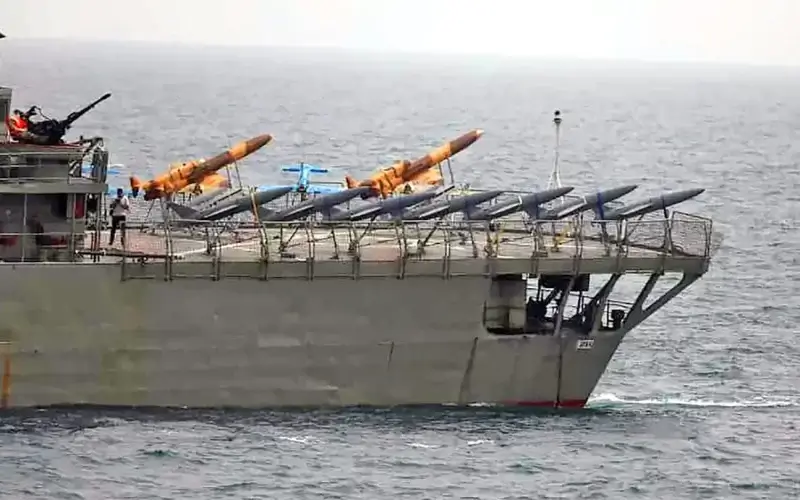The Iranian Navy has announced the introduction of what it's calling its inaugural “drone-carrier” division. A corresponding unveiling ceremony aired on Iranian state TV showing the navy launching drones from various ships and even a submarine. The display points to Iran's ongoing push to not only acquire more weaponized drone capabilities and capacity, but to deploy those systems via a diversified set of vectors — including from the sea. The new division was revealed while President Joe Biden was visiting Saudi Arabia in an effort to foster local support as tensions with Iran continue to rise just days after reports began to surface citing that Iran had offered to supply Russia with a significant amount of both armed and unarmed drones on an expedited timeline to bolster its invasion of Ukraine.
The new Iranian Navy division’s unveiling ceremony was held Friday, July 15 in international waters of the Indian Ocean with a number of high-ranking Iranian officials in attendance including Army Commander Major General Abdolrahim Mousavi. The event also seems to have doubled as a demonstration exercise, allowing the division a chance to showcase its use of ships, and submarines to deploy its locally produced drones. From the broadcasted ceremony, a Kilo-class submarine designated as Tareq, an auxiliary ship named Delvar, and the landing ship Lavan can be seen. While certain specific details about the division were not divulged, Reuters did report that Iranian state TV claimed one unnamed vessel currently carries at least 50 drones.
PressTV, which is also an Iranian state media outlet, claims that the division’s primary operations will consist of transporting and operating these various unmanned aerial vehicles (UAVs), which are said to be made up of combat, surveillance, and kamikaze types, although the Iranian state TV broadcast was seemingly focused on highlighting how a lot of these UAVs are kamikaze drones designed for carrying out strikes. As to the actual type of drones to be employed by the division, reports indicate that UAVs such as Pelican, Homa, Arash, Chamroosh, Jubin, Ababil-4, and Bavar-5 were all utilized during the unveiling ceremony.
Kian Sharifi, the senior journalist for BBC Monitoring, tweeted that the drone that can be seen launching from the Tareq submarine is identified as a Homa UAV. However, incredibly little is known about Homa at present aside from it being a reconnaissance UAV, and two total drones can be seen on Tareq in photos taken of the event posted by the MEHR News Agency. There’s one that actually launches from the surface and one that appears to be hovering over it.
While submarine-launched drones are becoming more commonplace, their uses are limited if the submarine has to surface to deploy them. Still, there are applications where launching them from a surfaced submarine might offer some value. Even developing the capability to transfer small items to and from a submarine via drone can be a worthwhile endeavor.
Also said to have been featured in the Iranian Navy’s “drone carrier” unveiling was the Pelican-2 drone, a vertical take-off naval UAV designed to fly horizontally as well as land and float on water in the event of an emergency. Pelican-2 was engineered to serve patrol and reconnaissance missions, with four motors that allow it to achieve vertical movement in addition to its powerful propellor used for horizontal flight. This 'hybrid' configuration is becoming more and more popular for naval applications. The Chamroosh UAV, however, is a less sophisticated drone being that the aircraft is hand-launched.
That leaves the Arash, Jubin, Ababil-4, and Bavar-5 drones. The Arash UAV is at the very least known to be a kamikaze drone first introduced in 2020 and was recently used during an annual Iranian war game exercise in 2021. The Ababil-4 is Iran’s second-newest addition to the Ababil family of drones designed by Ghods Aviation Industries and mass-produced by Iran Aircraft Manufacturing Industries. While few technical details are known about Ababil-4, its predecessors are used primarily for surveillance operations but can also be fitted with weapons depending on the mission. At a showcasing event in April of this year, the Ababil-5 was revealed to be carrying six Almas anti-tank guided missiles and was said to be capable of carrying Ghaem-5 precision-guided munitions.
Both the Bavar-5 and the Jubin UAVs, on the other hand, are newer and details about both of the drones’ configurations do not appear to be readily available. The delta-canard configuration seen on some of these drones is nothing new as it has been used for many Iranian drone designs, and especially those provided to its proxies, for years. These drones are usually associated with long-range 'suicide' attacks and can even potentially carry anti-radiation seekers for finding and striking enemy air defense radars.
Auxiliary-type ships that will allegedly support the Iranian Navy’s new “drone-carrier” division serve as another example of Iran developing capabilities to carry out asymmetric attacks far from its own shores. Iran is known to have used commercial ships discreetly for military purposes, which you can read more about in this past War Zone piece, and while these might not be super high-end platforms ready to face off with major navies, they definitely reflect real threats in other capacities.
The exporting of sea-launched drone capabilities to nefarious customers and especially its militant proxy forces is really a bigger issue than Iran displaying the capability itself. The fact is these drones could be launched from pretty much any ship, not just obvious 'drone carriers,' and even be employed against other ships. This can make attributing the source of attacks very challenging, as well as interdicting the launch platforms prior to deploying the drones.
That category of threats has been a growing friction point in the Middle East as of late, and The War Zone routinely highlights the fact that a low-intensity maritime drone war is already underway between Iran and Israel. Another drone event in Israel's maritime zone just occurred. The fear of proliferation of these systems, as well as cheap cruise missiles, has led to the possibility of a previously unthinkable alliance between the Arab states and Israel that could include a shared air defense network focused on early warning, tracking, and engaging these threats. The drones' small signatures and their ability to fly low, and in some cases slow, over great distances, along with their low cost, which allows for 'flocks' to be deployed against a single target area, even by non-state actors, make them an especially potent air defense challenge. The fact that they can be launched from pretty much any ship complicates things considerably. Israel is already preparing for such a contingency and the U.S. has major concerns about similar threats emanating from beyond its shores.
Meanwhile, Israel, which pioneered the 'suicide drone' concept, is also equipping its own ships with similar, albeit far more advanced systems.
Needless to say, Iran is evidently making prominent strides in indigenous weapons and capabilities development. How exactly this equipment will be used, and by who, however, remains to be seen.










